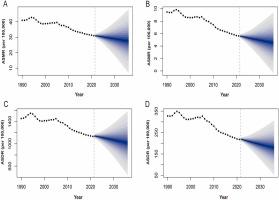The global burden of non-communicable diseases attributable to behavioral risk factors and its trends from 1990 to 2021
IF 13
1区 综合性期刊
Q1 MULTIDISCIPLINARY SCIENCES
引用次数: 0
Abstract
Background
Non-communicable diseases (NCDs) are one of the major challenges to global public health. High alcohol use, dietary risks, and low physical activity are three risk factors that can increase the burden of NCDs. Yet, a comprehensive study on the impacts of these three factors is currently lacking.Methods
The estimated annual percentage changes (EAPCs) were used to quantify trends in disease burden. Additionally, correlation analysis was performed to explore the relationship between disease burden and the socio-demographic index (SDI). Frontier analysis was utilized to examine the potential development space of 204 countries and regions, and predictive analysis was employed to study the trend of burden over the next 15 years.Results
From 1990 to 2021, the burden of NCDs caused by high alcohol use among males decreased significantly, with the disease burden most significant in the 40–90 age group. The disease burden caused by dietary risks in the 60–89 age group was evident. The burden of NCDs caused by low physical activity among females decreased significantly. In the next 15 years, the age-standardized mortality rate (ASMR) of NCDs will show a downward trend.Conclusions
The burden of NCDs has decreased but remains heavy. Countries should formulate and implement corresponding public health policies in light of their actual situations to reduce the disease burden.

1990年至2021年由行为风险因素造成的全球非传染性疾病负担及其趋势
背景非传染性疾病是全球公共卫生面临的主要挑战之一。高酒精使用、饮食风险和低身体活动是可能增加非传染性疾病负担的三个风险因素。然而,目前缺乏对这三种因素影响的综合研究。方法采用估计年百分比变化(EAPCs)量化疾病负担的变化趋势。此外,进行相关分析,探讨疾病负担与社会人口指数(SDI)之间的关系。采用前沿分析研究204个国家和地区的潜在发展空间,采用预测分析研究未来15年 年的负担趋势。结果从1990年到2021年,男性高酒精使用导致的非传染性疾病负担显著下降,其中40-90岁年龄组的疾病负担最为显著。在60-89岁年龄组中,饮食风险引起的疾病负担是明显的。女性身体活动不足造成的非传染性疾病负担显著下降。在未来15 年,非传染性疾病的年龄标准化死亡率(ASMR)将呈现下降趋势。结论非传染性疾病负担虽有所减轻,但仍很重。各国应根据本国实际情况制定和实施相应的公共卫生政策,减轻疾病负担。
本文章由计算机程序翻译,如有差异,请以英文原文为准。
求助全文
约1分钟内获得全文
求助全文
来源期刊

Journal of Advanced Research
Multidisciplinary-Multidisciplinary
CiteScore
21.60
自引率
0.90%
发文量
280
审稿时长
12 weeks
期刊介绍:
Journal of Advanced Research (J. Adv. Res.) is an applied/natural sciences, peer-reviewed journal that focuses on interdisciplinary research. The journal aims to contribute to applied research and knowledge worldwide through the publication of original and high-quality research articles in the fields of Medicine, Pharmaceutical Sciences, Dentistry, Physical Therapy, Veterinary Medicine, and Basic and Biological Sciences.
The following abstracting and indexing services cover the Journal of Advanced Research: PubMed/Medline, Essential Science Indicators, Web of Science, Scopus, PubMed Central, PubMed, Science Citation Index Expanded, Directory of Open Access Journals (DOAJ), and INSPEC.
 求助内容:
求助内容: 应助结果提醒方式:
应助结果提醒方式:


